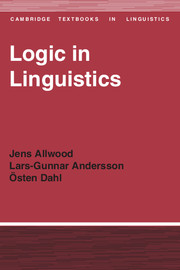Book contents
- Frontmatter
- Contents
- Preface
- Symbols and notational conventions
- 1 Logic for linguists
- 2 Set theory
- 3 Inference and logical analysis of sentences
- 4 Propositional logic
- 5 Predicate logic
- 6 Deduction
- 7 Modal logic
- 8 Intensional logic and categorial grammar
- 9 Further extensions
- 10 Logic for linguists?
- References
- Answers to exercises
- Index
10 - Logic for linguists?
Published online by Cambridge University Press: 05 June 2012
- Frontmatter
- Contents
- Preface
- Symbols and notational conventions
- 1 Logic for linguists
- 2 Set theory
- 3 Inference and logical analysis of sentences
- 4 Propositional logic
- 5 Predicate logic
- 6 Deduction
- 7 Modal logic
- 8 Intensional logic and categorial grammar
- 9 Further extensions
- 10 Logic for linguists?
- References
- Answers to exercises
- Index
Summary
General
In this final chapter, we shall discuss the relations between logic and linguistics and the extent to which logic provides useful insights for the study of natural language. It goes without saying that these problems are more controversial than those we have discussed in previous chapters.
Suppose that we want to know what logic can tell us about meaning and the semantic structure of natural language. The following are some of the questions that then arise.
(1) What concept of ‘meaning’ is found in logic? Is this concept useful for linguistic purposes?
(2) In what way can the formal languages of logic be used when we try to describe the meanings of expressions in natural language?
(3) Are the languages of logic sufficiently rich to serve as models for the semantics of natural languages? If the answer is no, is there any way to remedy the deficiencies?
Why these questions are asked may not be immediately obvious to the reader, but part of the understanding of the relations between logic and language consists in fact in grasping why they must be asked.
The concept of meaning
Let us begin with the first question. We should distinguish the following two fundamental problems of semantics.
(a) What is meaning in general?
(b) What are the meanings of particular expressions in a language?
- Type
- Chapter
- Information
- Logic in Linguistics , pp. 158 - 171Publisher: Cambridge University PressPrint publication year: 1977



